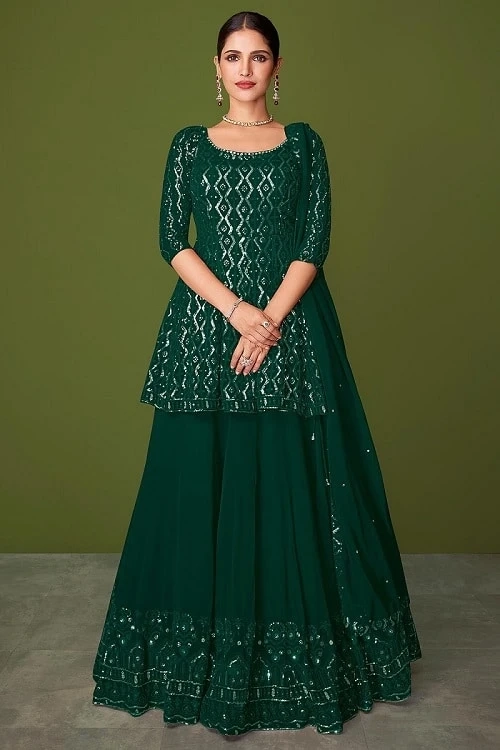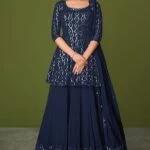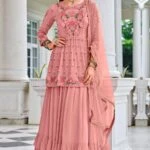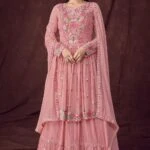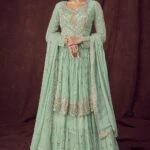Indian dresses evolve with time and era. According to the statistics, India is the second-largest country in the world in exporting garment and textile. The Indian fashion industry has marked its great influence in the global platform. Today along with traditional Indian dresses, contemporary Indian outfits have also marked their place in the market. In short, contemporary Indian outfits are a fusion of tradition and modernity. They have drawn their influence both from the traditional and the western styles. Designer lehengas, designer sarees, Indian evening gowns are the examples of contemporary Indian outfits. Through them, you will find the cultures of both East and West.
Speaking of contemporary outfits, peplum style is on trend in the market. And many Indian dresses, including Indian wedding dresses are in peplum style. You will find a lot of peplum style dresses online. Like A Diva is an online store that comes with different designs of peplum style lehengas and shararas that will give a mesmerising look.
Let us now look at the definition and history of peplum style dress and learn about how to wear and carry this style with grace.
What is Peplum Style?
In order to understand the peplum style, we need to first understand the meaning of the word peplum. A peplum is a ruffle in flare, found stitched in the waistline of a top, a blouse, a dress, a skirt or a jacket. It is added with extra frill to make the waist look noticeable. Peplum has its origin in Greece and it grew popular widely in the 19th century. These days, you can find peplum style in the fashion industry of almost all the countries. Contemporary Indian dresses, especially designer lehengas, shararas and other Indian wedding dresses are mostly found in peplum style.
Peplum style dress is a ruffle style dress that gives an hourglass shape to the body by accentuating the waist. Sometimes, some peplum style dresses like gowns and jackets are designed in such a way that they give an accentuated look to the shoulder.
Indian peplum style dresses, especially Indian wedding dresses come in different designs, patterns and fabrics. These Indian dresses are the new version of indo-western style. They come in either 3/4th sleeves, full sleeves or sleeveless. They give a contemporary yet a royal look to your getup.
History of Peplum Style
Like many other different styles of garments, peplum style also has its own history. Today, it may have mingled well with the Indian dresses and gained immense popularity in the Indian market, but western fashion world played a major role in its popularity. Emerging from ancient Greece, it has a story of its own. Let us now look at the history of peplum style dress.
- Peplum Style in Ancient Greece: Peplum style has its origin from ancient Greece. The word has been derived from the word “peplos” which is a Greek word. Peplos is a kind of tunic that the people of ancient Greece used to wear. Greek people used to wear it to give a perfect shape to their waist. It used to consist of a sheet in a folded form. People of ancient Greece used to wrap it around their body to give a perfect shape to their waist.
- Peplum Style in Renaissance Period: During this period, this style gained popularity in almost all parts of Europe. Both men and women started to wear peplum style dresses. Many believe that this peplum style is the early version of modern style peplums. Different garments such as jackets that men wore and the bodices that the aristocrat women used for their gowns were in peplum style. Sometimes these peplums would fall over the full length skirts.
- Peplum Style in the 19th century: During this period, it gained widespread popularity. It became a new fashion trend, especially among the women of that era. Because this style became easier for them to wear than the previous outfits. Below the overskirts in peplum style, they used to wear streamlined skirts.
- Peplum Style in 1940s: This style again gained its prominence after World War II. As after the second world war, having an hourglass body was on trend. It became so popular that people started adding this style to their daily wear garments along with the fashionable occasional wear. Many fashion designers like Christian Dior started featuring this style in their dress collections. Different types of garments like gowns, jackets and other dresses were found in peplum style.
- Peplum Style in 1980s: After 1940s, the popularity of peplum style faded away, until it became a trend again in 1980s. This style having a flared waistline again reigned the fashion world with a bit of twist. In this era, the style made its comeback in an exaggerated way. It came to be known as the “power suit”. People also started wearing this style for parties. In the 80s, the peplum design was found in the hips rather than on the waist.
- Peplum Style in the Contemporary Era: In today’s era peplum style has gained popularity all over the world. Fashion designers are becoming more creative with this style. Compared to the West, peplum style is gaining more popularity in Eastern countries like India and Pakistan. Most Indian wedding dresses are in peplum style these days. Designer lehengas, shararas are some of the examples of Indian dresses in peplum style. Generally the party wear Indian kurtis are found in peplum style.
Let us now look at how to wear these party wear, peplum style Indian kurtis to look royal and graceful.
Peplum Style kurtis with Lehenga Skirts
These are the most popular contemporary Indian dresses that most Indian women prefer to wear in a party. The peplum style kurtis are either long or short in length. They are either highly embellished with intricate designs or are simple with minimal work. They come in both the bold and bright colours and the pastel colours. Both the peplum kurti and the lehenga skirt come with different designs, motifs and patterns. They give you a dreamy, classy and charming look. These indo-western dresses give you both a regal and contemporary look. They come in different fabrics. These are the trendy Indian wedding dresses.
Peplum Style kurtis with Sharara Pants
You can also pair a peplum style party wear kurti with a pair of sharara pants to get a mesmerising look. These Indian wedding dresses give you a dolled up look. They make you look royal and majestic. This fusion wear comes with the intricate embroidery designs. These designs are made in different fabrics in peplum style. They give you a chic and charming look.
Peplum Style kurtis with Palazzo Pants
Apart from sharara pants and lehenga skirts, you can also team up a peplum style kurti with a pair of palazzo pants. This gives you a stylish look for a party. It is comfortable and easy to wear. It comes in different designs, patterns and fabrics. These are the best Indian dresses for a bridesmaid.
Summing Up
When it comes to Indian dresses, peplum style mingles well with different styles of Indian outfits. The blouse of designer lehengas can be in peplum style. Moreover Indian wedding dresses like shararas and palazzo suits can also be in peplum style. Indian outfits are of different styles and designs, therefore they fuse well with the western style as well.
0



